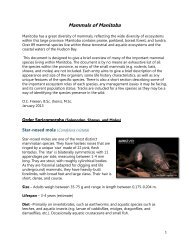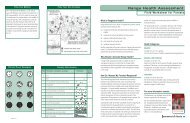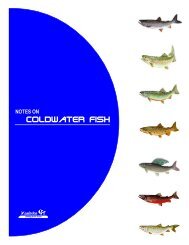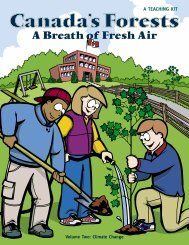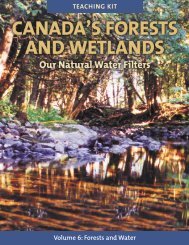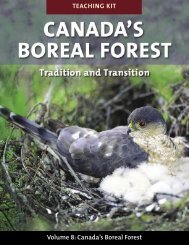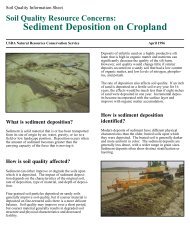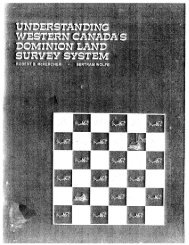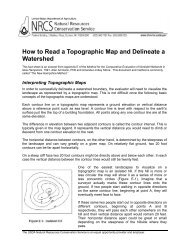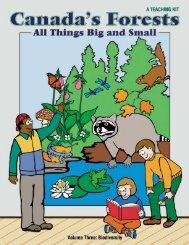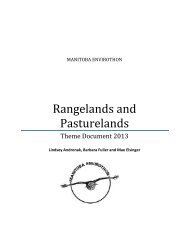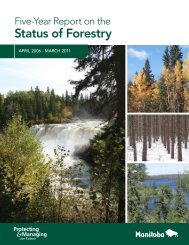Soil Biodiversity - NRCS Soils - US Department of Agriculture
Soil Biodiversity - NRCS Soils - US Department of Agriculture
Soil Biodiversity - NRCS Soils - US Department of Agriculture
You also want an ePaper? Increase the reach of your titles
YUMPU automatically turns print PDFs into web optimized ePapers that Google loves.
<strong>Soil</strong> Quality Information Sheet<strong>Soil</strong> Quality Resource Concerns: <strong>Soil</strong> <strong>Biodiversity</strong><strong>US</strong>DA Natural Resources Conservation Service January 1998What is soil biodiversity?<strong>Soil</strong> biodiversity reflects the mix <strong>of</strong> living organisms in thesoil. These organisms interact with one another and withplants and small animals forming a web <strong>of</strong> biologicalactivity.<strong>Soil</strong> is by far the most biologically diverse part <strong>of</strong> Earth.The soil food web includes beetles, springtails, mites,worms, spiders, ants, nematodes, fungi, bacteria, andother organisms. These organisms improve the entry andstorage <strong>of</strong> water, resistance to erosion, plant nutrition,and break down <strong>of</strong> organic matter. A wide variety <strong>of</strong>organisms provides checks and balances to the soil foodweb through population control, mobility, and survivalfrom season to season.What are the benefits <strong>of</strong> soilorganisms?Residue decomposition<strong>Soil</strong> organisms decompose plant residue. Each organismin the soil plays an important role. The larger organisms inthe soil shred dead leaves and stems. This stimulatescycling <strong>of</strong> nutrients. The larger soil fauna include earthworms,termites, pseudoscorpions, microspiders, centipedes,ants, beetles, mites, and springtails.When mixing the soil, the large organisms bring materialto smaller organisms. The large organisms also carrysmaller organisms within their systems or as “hitchhikers”on their bodies.Small organisms feed on the by-products <strong>of</strong> the largerorganisms. Still smaller organisms feed on the products<strong>of</strong> these organisms. The cycle repeats itself several timeswith some <strong>of</strong> the larger organisms feeding on smallerorganisms.Some larger organisms have a life span <strong>of</strong> two or moreyears. Smaller organisms generally die more quickly, butthey also multiply rapidly when conditions are favorable.The food web is therefore quick to respond when foodsources are available and moisture and temperatureconditions are good.Infiltration and storage <strong>of</strong> waterChannels and aggregates formed by soil organismsimprove the entry and storage <strong>of</strong> water. Organisms mixthe porous and fluffy organic material with mineral matteras they move through the soil. This mixing action providesorganic matter to non-burrowing fauna and createspockets and pores for the movement and storage <strong>of</strong> water.Fungal hyphae bind soil particles together and slime frombacteria help hold clay particles together. The waterstableaggregates formed by these processes are moreresistant to erosion than individual soil particles. Theaggregates increase the amount <strong>of</strong> large pore space whichincreases the rate <strong>of</strong> water infiltration. This reducesrun<strong>of</strong>f and water erosion and increases soil moisture forplant growth.Nutrient cycling<strong>Soil</strong> organisms play a key role in nutrient cycling. Fungi,<strong>of</strong>ten the most extensive living organisms in the soil,produce fungal hyphae. Hyphae frequently appear likefine white entangled thread in the soil. Some fungalhyphae (mycorrhizal fungi) help plants extract nutrientsfrom the soil. They supply nutrients to the plant whileobtaining carbon in exchange and thus extend the rootsystem. Root exudates also provide food for fungi,bacteria, and nematodes.
When fungi and bacteria are eaten by various mites,nematodes, amoebas, flagellates, or ciliates, nitrogen isreleased to the soil as ammonium. Decomposition by soilorganisms converts nitrogen from organic forms indecaying plant residues and organisms to inorganic formswhich plants can use.Management considerationsCover crops and crop rotationsThe type <strong>of</strong> crops that are used as cover or in croprotations can affect the mix <strong>of</strong> organisms that are in thesoil. They can assist in the control <strong>of</strong> plant pests or serveas hosts to increase the number <strong>of</strong> pests. Different speciesand cultivars <strong>of</strong> crops may have different effects on pests.However, the organisms and their relation to the crop arepresently not clearly understood.CultivationThe effects <strong>of</strong> cultivation depend on the depth andfrequency <strong>of</strong> the cultivation. Tilling to greater depths andmore frequent cultivations have an increased negativeimpact on all soil organisms. No-till, ridge tillage, and striptillage are the most compatible tillage systems thatphysically maintain soil organism habitat and biologicaldiversity in crop production.Compaction<strong>Soil</strong> compaction reduces the larger pores and pathways,thus reducing the amount <strong>of</strong> suitable habitat for soilorganisms. It also can move the soil toward anaerobicconditions, which change the types and distribution <strong>of</strong> soilorganisms in the food web. Gaps in the food web inducenutrient deficiencies to plants and reduce root growth.Full WebCropsWeedsRootsAlgaeLichensBacteriaOrganic MatterPhotosynthesizersAbovegroundHerbivoresPests & Pathogens* Root-feedingNematodes& Insects* Fungi* BacteriaMutualists* MycorrhizalFungi* N-fixing BacteriaDecomposers* Fungi* Bacteria* ShreddersPrimaryConsumersAbovegroundCarnivoresBelowgroundOmnivorousNematodesFungal-feeders* Centipedes* Nematodes* MitesBacterial-Feeders* Nematodes* Protozoa• Ciliates• Amoebae• Flagellates* EnchytraeidsSecondaryConsumersHigh-levelCarnivoresEarthwormsMillipedesPredatoryNematodesPredatory MitesTertiaryConsumersBirdsMiceBeetlesSpidersPredatory Insectsand higher ...Pest controlPesticides that kill insects also kill the organisms carriedby them. If important organisms die, consider replacingthem. Plant-damaging organisms usually increase whenbeneficial soil organisms decrease. Beneficial predatororganisms serve to check and balance various pestspecies.Crop residue managementMixing crop residue into the soil generally destroys fungalhyphae and favors the growth <strong>of</strong> bacteria. Since bacteriahold less carbon than fungi, mixing <strong>of</strong>ten releases a largeamount <strong>of</strong> carbon as carbon dioxide (CO 2). The net resultis loss <strong>of</strong> organic matter from the soil.Herbicides and foliar insecticides applied at recommendedrates have a small impact on soil organisms.Fungicides and fumigants have a much greater impact onsoil organisms.FertilityFertility and nutrient balances in the soil promote biologicaldiversity. Typically, carbon is the limiting resource tobiological activity. Plant residue, compost, and manureprovide carbon. Compost also provides a mix <strong>of</strong> organisms,so the compost should be matched to the croppingsystem.(Prepared by the National <strong>Soil</strong> Survey Center, <strong>NRCS</strong>, <strong>US</strong>DA in cooperation with the <strong>Soil</strong> Quality Institute, and the National <strong>Soil</strong> Tilth Laboratory,Agricultural Research Service, <strong>US</strong>DA).When crop residue is left on the soil surface, primarydecomposition is by arthropod shredding and fungaldecomposition. The hyphae <strong>of</strong> fungi can extend frombelow the soil surface to the surface litter and connect thenitrogen in the soil to the carbon at the surface. Fungimaintain a high C:N ratio and hold carbon in the soil. Thenet result is toward building the carbon and organicmatter level <strong>of</strong> the soil. In cropping systems that returnresidue, macro-organisms are extremely important.Manage the soil to increase their diversity and numbers.Visit our Web site:http://soils.usda.gov________________________________________________________________________________________________The U. S. <strong>Department</strong> <strong>of</strong> <strong>Agriculture</strong> (<strong>US</strong>DA) prohibits discrimination in its programs on the basis <strong>of</strong> race, color, national origin, gender, religion, age,disability, political beliefs, sexual orientation, and marital or family status. (Not all prohibited bases apply to all programs.) Persons with disabilities whorequire alternative means for communication <strong>of</strong> program information (Braille, large print, audiotape, etc.) should contact <strong>US</strong>DA’s TARGET Center at (202)720-2600 (voice and TDD).To file a complaint <strong>of</strong> discrimination, write <strong>US</strong>DA, Director, Office <strong>of</strong> Civil Rights, Room 326W, Whitten Building, 14th and Independence Avenue, SW,Washington, DC 20250-9410 or call (202) 720-5964 (voice or TDD). <strong>US</strong>DA is an equal opportunityprovider and employer.



